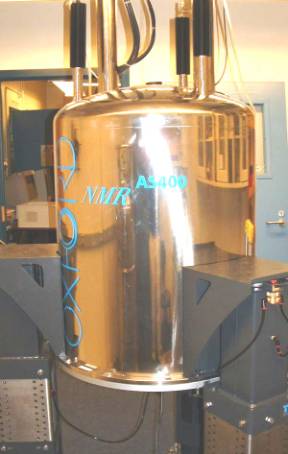
Nuclear Magnetic Resonance Spectroscopy Wikipedia entry
Manual
Information Schema
Notes
- WARNING: STRONG MAGNETIC FIELD!
- Read all warnings posted near instrument.
- The NMR has a hardware console. The PC connects to the NMR console via ethernet cable.
- The PC is configured with a dedicated private [10.10.] network.on eth1.
- eth0 is on TESC LAN w/ static IP 10.14.3.200
- Student access to the PC:
- UN: student
- PW: c13nmr
- Network Information
- PC is not joined to the domain;
- If accessing resources on TESC LAN network, and credentials are required, when prompted for "domain name" use AC_COMPUTING [this is the legacy Windows NETBIOS name]
- There's a shorcut on the desktop [called NMR-Data-to-Orca] to \\Orca\research\NMR-Data [this is a 'static' connection using the acuser domain account]
- The reference hardware/software serial #: S010780
- The software (VnmrJ 2.2D) license codes
- G5023AA
- G5027AA
- The software (VnmrJ) will create raw free induction decay (FID) files
- These files can be directed to the network share by browsing to \Home\student\desktop\NMR-Data-to-Orca
- These raw FID files can be read by Acorn NMR Inc. NUTS software.
- These raw FID files can be read by ACD NMR Processor software.
- The CAL has this software installed.
- Help files/Manuals are located on the desktop
- /home/student/desktop/VnmrJ_Manual/
- These files can be directed to the network share by browsing to \Home\student\desktop\NMR-Data-to-Orca
- VnmrJ Issues/Bugs:
- If the software is closed by clicking on the window x icon to close the application, VnmrJ will leave behind a lock file within the users profile.
- The issue/Bug will be experienced if the user tries to open the application again, and tries to start a new test, VnmrJ will display an error.
- Assuming that the user is "Student", the lock file will be found in this directory: \Home\Student\VNMRsys
- the lock file will have a .primary file extension as well as having "lock" in the file name;
- for example: rm_lock_4.primary
- in the example, the 4 will represent the "4" or "4th" test.
- General instrument information
- The helium needs to be recharged every 4 month [MAX believed to be 6 months]
- The liquid nitrogen needs to be recharged every 1 week [Max is believed to be 2 weeks]
- Consequence of failure to recharge aformentioned gases is "Magnetic Quench"!
- It's estimated that it would/will cost $15K to fix should quench occur.
